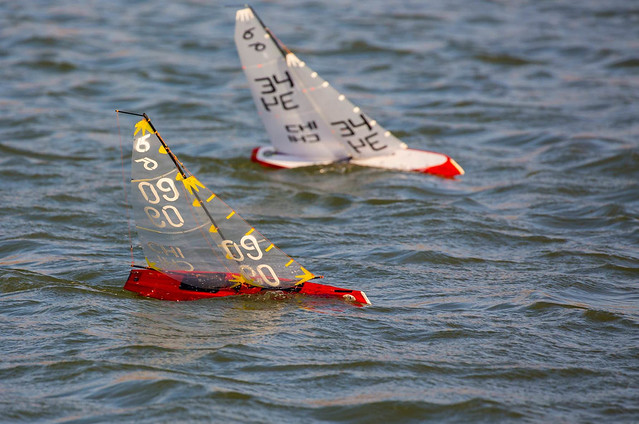After the publication of the new IOM plan with short LWL “IOM-SL”, I decided to run the same exercise with an RG65 “Arrow-1”. The LWL is reduced from 650mm to 590mm.
See attached IOM and RG65 plans
ClaudioD
Hi Claudio!
The hull lines look very gorgeous… I like the elevated bow! But you need to explain a little bit more here… Why would a shorter LWL be benefical? I did not read anything related to the IOM version… can you explain the rationale of this?
PD: that bumber is not RG65 class legal… should be 5mm +/-1mm in its entire height…
Hi Thomas,
Some time ago started the Narrow Hull “Fashion” and I was invited to design a Narrow Hull for the RG65, and so I did it. Today many are reporting that the narrow hulls are often winner boats.
For me is very pleasant to read the performance report you wrote.
Not too long ago a friend of mine calculated the wind effects on Sails and Hull.
Although not confirmed by more precise evaluations, it concluded that a sailing boat, navigating in close hauled condition, is sinking down the water proportionally to the Wind Force on Sails.
For a Class M, the displacement increase, due to sinking, would be changing from: 0% at Zero tilt up to 12.5% at 30° tilt.
Now, assume a hull having a Water Plan as long as the overall length and the boat sinking under wind pressure, The hull body will be modified producing a deformation of the design waterlines and for sure the transom will be affected introducing additional turbulence.
Stepping out from above condition, the Wet Area of a sailing boat is the major contributor to drag at low speed.
The LWL is matter when the boat speed is close to the Critical Speed and of course the wind should be also strong.
With low windy conditions and therefore with boat low speed, the Waterline length is not anymore a major issue.
The ideal would be that under breeze conditions, the Water Plan would be as normally seen on hundred of designs where the Design Waterlines are drawn.
Base on upon considerations, I told myself that the waterline could be shortened in order to reduce the Wet Area. My calculations are suggesting a reduction of about 5%.
Lower Wet Area = Higher Speed under Low Wind conditions.
Different situation will occurs when the wind will start increasing, the boat will heel more and the Water Plan area will increase due to the sinking effect and the water lines will be increase too.
The small overhangs will also participate to the LWL increase.
Finally, with this approach, I do have a variable LWL as function of the Wind Speed !
This is why !
Of course nothing is free, btw this is an experimental design.
I have exploited the small volumes at both ends of the hull and increased the water beam for the amount needed.
[i]Sorry for the length, hoping explained my thinking.
The drawing below should represent the static variation of Water Plan surface of the same Sailing Boat. For simplicity the tilting effect is ignored.
Claudio
PS: You are right about bumper sizing
[/i]
Thanks for the explanation Claudio! I’m surprised I never read before about the third component of the force on sails! Makes complete sense now!!!
BTW, I did notice during last event that the nArrow5 was sailing lower with a breeze, and I thought “I’m sinking!!!”… After inspection, there was only little water in the hull (explained by rudder control rod hole being too big). Maybe the reason of this behaviour is what you have noticed… and the nArrow5 shape makes it more evident?
Anyway, already started replacing the bulb by a new lighter one (old keel+bulb = 662gr). I want to remove about 100gr, and bring displacement down to about 850gr. Also, I’m planing to remove 3 or 4cm of the keel length. I really hope this will increase performance. Maybe I’ll see the effect you describe above…
Warm regards,
Thomas
PD: this is the nArrow5 “El Chueco” sailing at the Copa del Pacífico with small C-rig (60% of max sail area):

Hi Thomas,
I was discussing today with my friend and he told me a little story. He came into possession of an old hull designed by a common friend.
This boat was not really going well.
Because at the moment there the tendency to reduce the fin area, he decided to substitute the original Fin with an Helicopter blade much more narrower.
In total the surface was reduced to 100/102cm². With that Blade installation the boat performances are now totally different, according to him, is actually the fastest boat in the water and no drift observed.
The principle I use for the appendices a total area equivalent to 6.0 - 6.3% of the sail area.
Indeed taking 2250 cm² max sail area x 6 % = 135 cm².
This surface is divided by 3/4 for the Fin and 1/4 for the Rudder.
It may possible that the rudder surface need to be adapted to the wind conditions, playing on the Aspect Ratio.
Cheers
Claudio
PS: I have introduced a modification for the bumper with more flare